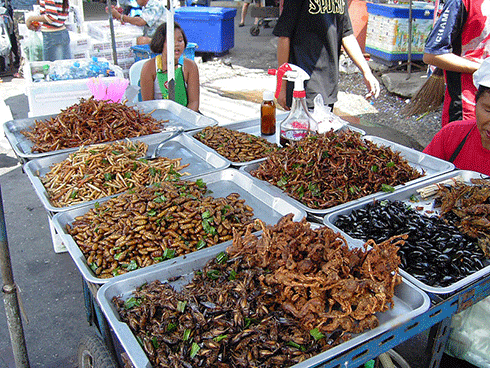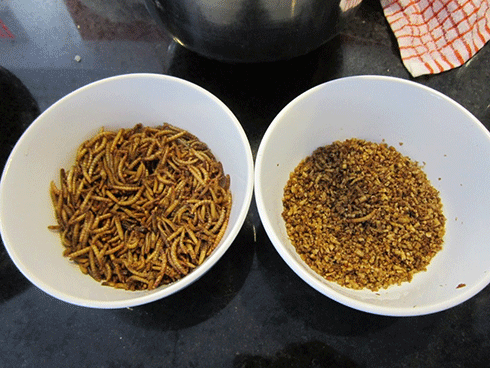
|
Published: 24 February 2014
The noisy future of farming
How will we sustain protein levels in our future food supply, in a world where 9 billion-plus people will be pushing the planet’s farming and aquaculture systems to the limit? Grain prices will almost certainly go up and so will the price of meat, as livestock depend on these grain supplies. Insects, though, offer a good alternative – healthy, easy to raise, and much more efficient in processing vegetable matter into animal protein.

|
|
Deep-fried insect food stall in Bangkok, Thailand. Counter-clockwise, from the back-left to the front: locusts, bamboo-worms, moth chrysalis, crickets, scorpions, diving beetles and giant water beetles. Credit:
Wikimedia Commons/Takoradee
|
The United Nations released a report last year advocating an accelerated shift to insect consumption in the west. The report claimed that crickets use one-twelfth the feed required by cattle to produce an equal amount of protein.
Attending a Dutch-hosted, bug-eating, embassy reception last year, I was interested to watch people’s reactions to the cuisine – the cricket guacamole, the cicadas and asparagus on a stick, the mealworm pancakes. As most guests realised, bugs don’t taste like much when integrated into a complex recipe.
The easiest way to integrate insects into the western diet will be through processed foods where the distinct crunch and taste of bugs is lost and just the healthful and sustainable source of protein is preserved.
This approach has already moved forward to some degree in the Netherlands – at specialty grocery stores, shoppers can buy freeze-dried bug patties. At the embassy event there were even samples of
All of this imagines a factory-farmed bug future where agribusiness grows and sells insect protein at a large scale to fill the processed foods that now mostly have ground-up chicken, pig and beef bits in them.
Certainly an improvement, ecologically speaking, but considering how unhealthy most processed foods are – filled with salt, sugar, preservatives and artificial flavours and served in unsustainable and often toxic packaging – maybe not so large a step forward as we could take.
During the embassy event there was long discussion of a future of factory-farmed bugs – which one expert assured the audience was just fine, as insects like crowded conditions and their diseases don’t easily migrate to humans like the diseases that affect current livestock do.
But can’t we do better? Massive amounts of waste will still be created – will it pour down rivers like chicken, pig, and cow manure currently does?
In colonies of millions of bugs, conditions will be ripe to spread new insect diseases, which may, in turn, mean continuing reliance on huge amounts of antibiotics or fungicides for our new ‘livestock’ (even if there’s no risk of these diseases spreading to humans). And perhaps worst of all, the industrial model, with its concentration of profits, will continue.

|
|
Bowl of mealworms waiting to be added to pancakes made by the author of Girl Meets Bug. Credit:
Erik Assadourian
|
The most exciting moment for me at this event came when the expert mentioned in passing that 20,000 households in Thailand make part of their living from raising crickets or other bugs.
Now this is the future I’d like to see. Everyone can raise a fish tank full of crickets using their own food scraps and rotting plant matter, and probably generate a free pound of animal protein every month or so – just enough for a minimum dietary intake, with the added benefit of lower overall household costs (while having a positive ecological effect as factory-farmed meat is displaced by freegan crickets).
This idea raises some intriguing questions: How does one go about raising a small quantity of crickets for personal consumption? What are the hours of work time needed to sustain your flock? The inputs? Will food scraps and foraged bits of yard waste from your and neighbours’ yards or local parks be enough or, like larger-scale cricket farmers, would one need to buy chicken feed (which would change the financial equation dramatically)?
With current meat prices, small-scale production of crickets probably can’t pay for itself right now (not if time costs are factored in and environmental externalities aren’t), but once food is no longer easily or cheaply purchased at the local supermarket, insect farmers may be some of the best equipped to survive food shortages.
That’s food for thought, even if you have to catch it first.
Erik Assadourian is a Senior Fellow at the Worldwatch Institute, where he has studied cultural change, consumerism, economic de-growth, ecological ethics, corporate responsibility, and sustainable communities. He has directed two editions of Vital Signs and four editions of State of the World. This article first appeared at the WI blog and is reproduced with permission.



